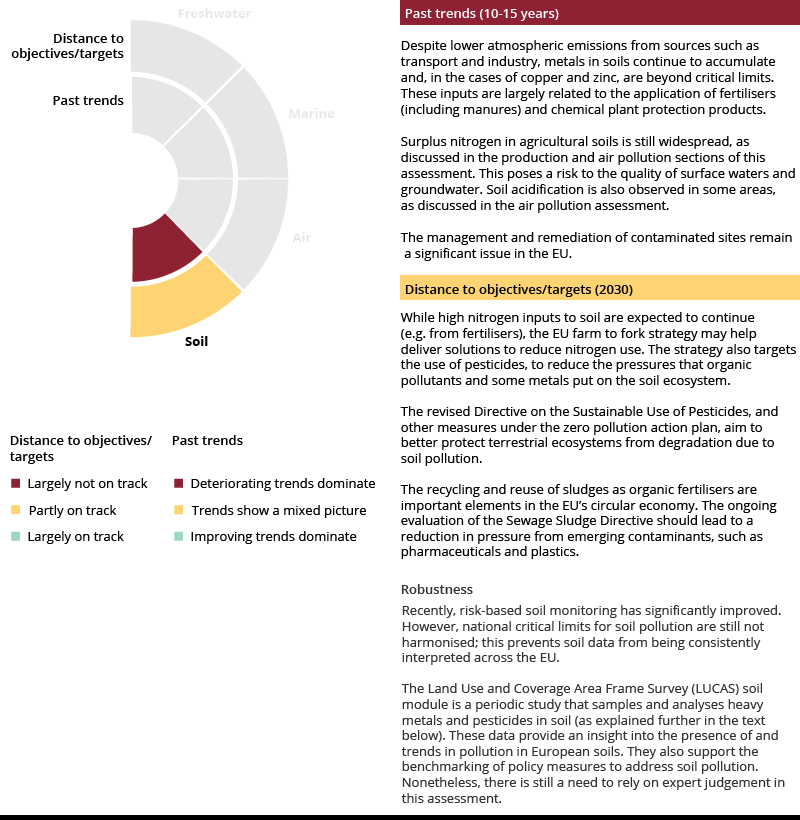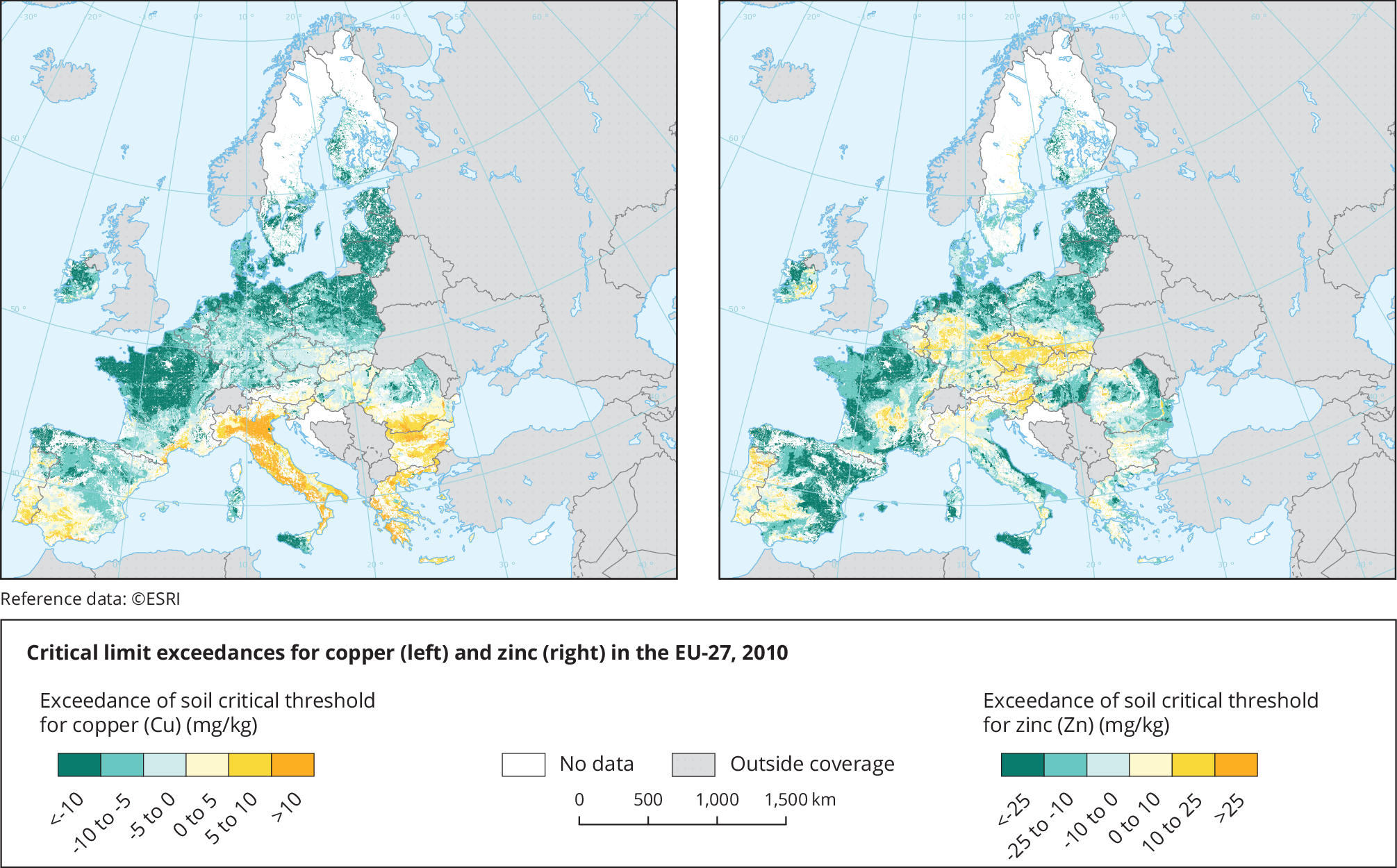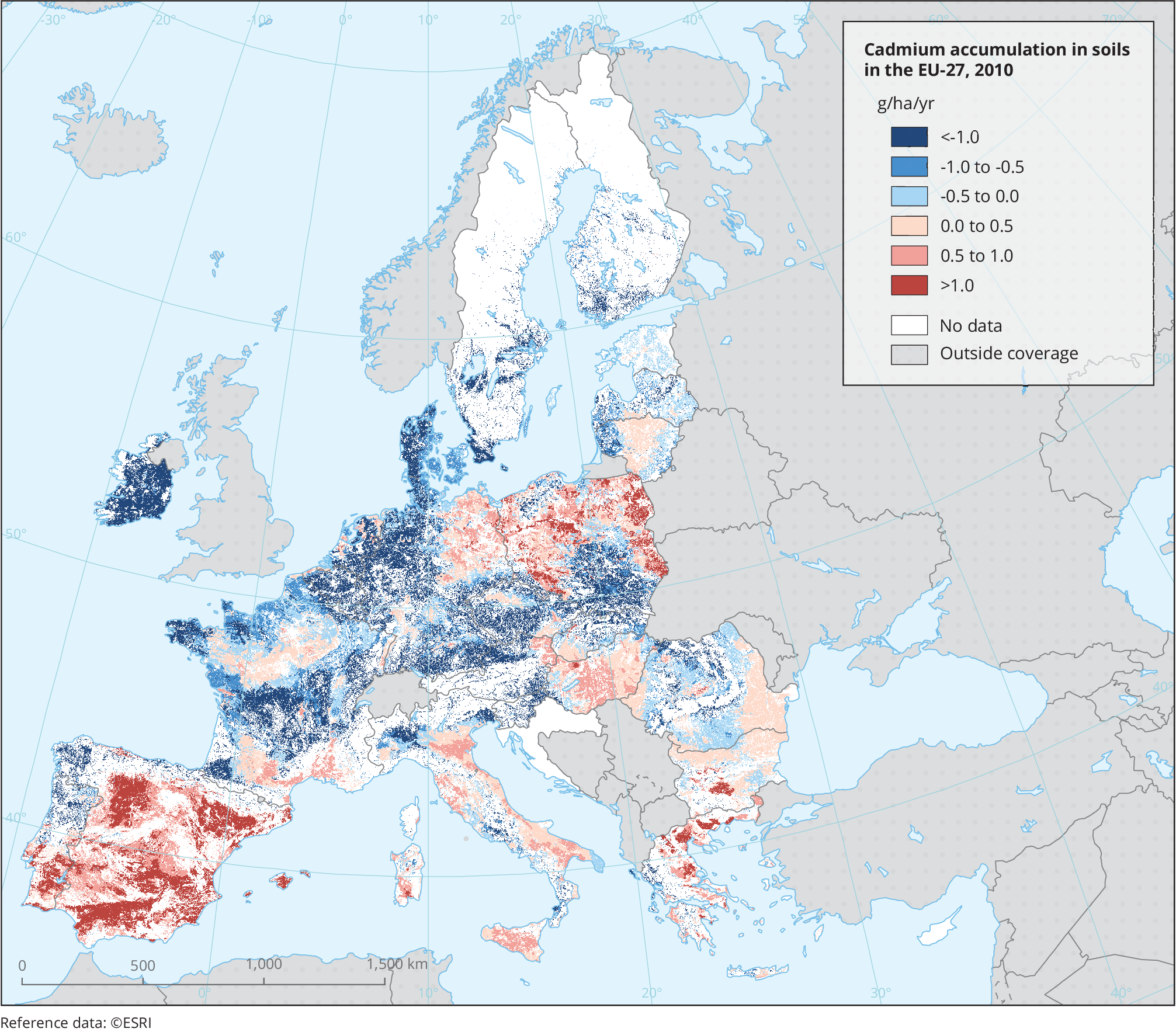Key messages
- The intensity and impact of soil pollution vary significantly across Europe. There is evidence that heavy metals and persistent organic pollutants are accumulating in soils despite decreases in the release of these pollutants from sources such as industry and transport.
- Levels of copper and zinc in soils exceed safe thresholds, particularly in areas with intensive livestock management as a result of pollutants in manure.
- Less is known about soil pollution and its associated impacts on ecosystems than about other issues, such as air pollution. There is a need for ongoing, targeted monitoring to better inform decision-making and to assess progress towards meeting the long-term zero pollution objectives.

Note: Link to further data on LUCAS.
Guidance for interpreting the summary
The infographic above summarises the analysis completed below on soil pollution. Two distinct elements are considered:
- whether the past trend in pollution is positive, negative or uncertain
- the current 'distance to target', based on an assessment of the current trends or status and whether or not the EU is on track to achieve the defined zero pollution targets for 2030 and/or other relevant policy targets.
The analysis is based on a combination of (1) available indicators and data, as presented below, and (2) expert judgement.
Introduction
Soil is essential for all terrestrial ecosystems and their biodiversity. An active and healthy biological soil ecosystem with a diversity of soil animals and microbes is needed to make sufficient nutrients available, and to decompose, filter and/or immobilise pollutants. Soil’s biochemical capacity is key to allowing terrestrial ecosystems to thrive; it also largely determines how contaminants are transported to lower soil layers with the percolating soil water.
Pollutants can enter soil through various pathways, including atmospheric deposition (e.g. of heavy metals, nitrogen), direct application (e.g. of synthetic fertilisers, manure, pesticides, sludges, waste) and accidents (e.g. spills at industrial sites). These contaminants affect soil in four ways:
- The diversity and activity of soil-dwelling organisms are affected, and plant species diversity is reduced. The soil ecosystem is directly affected by contamination; once toxic levels are reached, sensitive species are eliminated in favour of a few dominating ones.
- Contaminants typically enter the food chain through soils. Plants and animals take up contaminants into their tissues and pass them on to organisms of higher trophic levels, including humans.
- Drinking and irrigation water contamination depends on the soil passage and the soil’s filtering capacity. Contaminants pass through the soil into aquifers through leaching and subsurface run-off.
- Flooding, water erosion, surface run-off and wind erosion redistribute contaminants. This affects urban as well as rural areas.
In Europe, the chemical contamination of soils is widespread. This takes place at local sites (mostly in urban areas), at mining locations and in larger areas, such as those under agricultural management or previously flooded land. The two main categories of pollutants affecting soil are heavy metals and organic contaminants. Recently, pollution by pharmaceuticals and plastics has become an emerging concern.
The intensity and impact of soil pollution vary significantly across Europe. This is due to the large differences across regions with respect to soil properties, land use, the type and number of agricultural inputs (fertilisers or manure) and climate.
The EU soil strategy for 2030 reiterates the general zero pollution ambition: by 2050, soil pollution should be reduced to levels no longer considered harmful to human health and the environment (EC, 2021). It also prioritises pollution prevention at source, aligning with the zero pollution hierarchy. Moreover, the European Commission is preparing to propose a soil health law with legally binding provisions, such as the requirement to identify and remediate contaminated sites.
Plants growing in soils polluted with heavy metals may show a reduction in growth, performance and yield (Chibuike and Obiora 2014; Zhu et al., 2020). Evidence also suggests that metal pollution significantly reduces the diversity of bacterial communities by up to 90% (Gans et al., 2005).
The distribution of heavy metals in agricultural soils has recently been documented by the EEA (De Vries et al., 2022). While copper and zinc are essential plant micronutrients in trace amounts, high concentrations lead to an exceedance of critical levels — thresholds above which harm to soil ecosystems can occur. Such exceedances are seen across a significant proportion of Europe’s agricultural areas. Copper, for example, has been extensively used as a fungicide, especially in vineyards to combat mildew; this land use is considered a significant cause of soil copper pollution (Ballabio et al., 2018). Copper and zinc mainly reach the soil through animal manure (77% and 78%, respectively) (De Vries et al., 2022). Future zero pollution monitoring at the EU level will build on the Land Use and Coverage Area Frame Survey (LUCAS) soil module, through which heavy metals and other contaminants are now regularly being monitored.

Notes : In each map the colours represent the level of exceedance of the thresholds in units of mg of each metal per kilogram of soil. For values less than zero, there is no exceedance. Only values greater than zero indicate an exceedance of the critical limit in each case.
Source: De Vries et al. (2022).
Click here to view the map enlarged
Click here for different chart formats and data
Map 7 shows the areas in which soil metal content exceeds critical levels in terms of ecotoxicological effects on soil organisms. Critical limits for copper and zinc are exceeded in 23% and 18% of the EU-27’s arable lands assessed, respectively. This means that the amounts of these metals in soils are too high in a significant area (De Vries et al., 2022).
Cadmium is a toxic heavy metal that largely contaminates soil via mineral fertilisers (which account for around 43% of contamination). It does not exceed critical limits (De Vries et al., 2022). However, soil cadmium levels are slightly increasing in areas with calcareous soils and/or low precipitation inputs (Map 8). This may lead to long-term negative effects on the quality of food, groundwater and surface waters.

Notes: The map shows areas where cadmium levels are accumulating (with values greater than zero) and depleting (with values less than zero). Accumulation rates have been slowing more recently as a result of lower application rates of inorganic fertilisers and lower levels of input from atmospheric pollution.
Source: De Vries et al. (2022).
Click here to view the map enlarged
Click here for different chart formats and data
Pollution of agricultural land through organic pollutants
Persistent organic pollutants (POPs), which include many herbicides, fungicides and insecticides, are investigated in routine soil monitoring (Hvězdová et al., 2018). Additional data come from the 2018 LUCAS soil module, which monitored 3,470 sites for pesticides (JRC, 2022; Orgiazzi et al., 2022). While there is rich literature on POP prevalence in soils, knowledge about POP accumulation in larger areas — and the resulting environmental impact — is still limited (FAO and UNEP, 2021).
In a representative sample of European agricultural soils (monitored as part of the LUCAS soil module), more than 80% of the soils tested contained pesticide residues (Silva et al., 2019). Geissen et al. (2021) reviewed the risks of pesticides and possible cocktail effects on soil organisms. Considering that these substances are toxic, DNA damage in earthworms, changes in enzymatic activity and bacterial imbalances are possible. Soil composition can also influence how easily pesticides may find their way into water bodies, with the risk of pesticide movement being highest for coarsely textured soils (McGinley et al., 2022).
Nutrient pollution
Nutrient pollution sources and impacts are discussed in other parts of this zero pollution monitoring assessment and will not be repeated in detail here. This includes assessing progress towards targets to reduce nutrient losses by 50%, reducing air pollutant impacts on ecosystems by 25% and reducing the influence that excess nutrients can have on bathing water and drinking water.
It is clear that soil ecosystems play an important role in transporting these pollutants into waterways; for example, only 60-65% of the nitrogen applied to agricultural land in Europe is taken up by crops (De Vries et al., 2022). Nutrient deposition (primarily ammonia from agriculture) on land also harms a significant proportion of EU terrestrial habitats.
In addition, while sludges from wastewater treatment plants benefit crop growth because of their nutrient content, other contaminants can also be present in sludges. The use of sludges requires careful monitoring and assessment to prevent pollution as detailed in the zero pollution ‘Signal’ on assessment of the impacts of sewage sludge spreading. The ongoing evaluation of the Sewage Sludge Directive should help reduce pressure from emerging contaminants such as pharmaceuticals and plastics.
Indicator analysis – soil pollution and ecosystems
The zero pollution and health section assesses the EEA indicator on progress in the management of contaminated sites. No other formal indicators are currently available for soil pollution and ecosystems.
References
Ballabio, C., et al., 2018, ‘Copper distribution in European topsoils: an assessment based on LUCAS soil survey’, Science of the Total Environment 636, pp. 282-298 (https://doi.org/10.1016/j.scitotenv.2018.04.268).
Chibuike, G. U. and Obiora, S. C., 2014, ‘Heavy metal polluted soils: effect on plants and bioremediation methods’, Applied and Environmental Soil Science 1, pp. 1-12 (http://dx.doi.org/10.1155/2014/752708).
De Vries, W., et al., 2022, Impacts of nutrients and heavy metals in European agriculture — current and critical inputs in relation to air, soil and water quality, ETC-DI Report 2022/01, European Topic Centre on Data Integration and Digitalisation (https://www.eionet.europa.eu/etcs/etc-di/products/impacts-of-nutrients-and-heavy-metals-in-european-agriculture-current-and-critical-inputs-in-relation-to-air-soil-and-water-quality.) accessed 13 October 2022.
EC, 2021, Communication from the Commission to the European Parliament, the Council, the European Economic and Social Committee and the Committee of the Regions ‘EU soil strategy for 2030 — reaping the benefits of healthy soils for people, food, nature and climate’ (COM (2021) 699 final of 17 November 2021) (https://eur-lex.europa.eu/legal-content/EN/TXT/PDF/?uri=CELEX:52021DC0699&from=EN) accessed 13 October 2022.
FAO and UNEP, 2021, Global assessment of soil pollution — summary for policy makers, Food and Agriculture Organization of the United Nations, Rome (https://doi.org/10.4060/cb4827en).
Gans, J., et al., 2005, ‘Computational improvements reveal great bacterial diversity and high metal toxicity in soil’, Science 309(5739), pp. 1387-1390 (https://doi.org/10.1126/science.1112665).
Geissen, V., et al., 2021, ‘Cocktails of pesticide residues in conventional and organic farming systems in Europe — legacy of the past and turning point for the future’, Environmental Pollution 278, 116827 (https://doi.org/10.1016/j.envpol.2021.116827).
Hvězdová, M., et al., 2018, ‘Currently and recently used pesticides in central European arable soils’, Science of the Total Environment 613-614, pp. 361-370 (https://doi.org/10.1016/j.scitotenv.2017.09.049).
JRC, 2022, LUCAS 2018 soil module — presentation of dataset and results, JRC Technical Report JRC129926, Publications Office of the European Union, Luxembourg (http://dx.doi.org/10.2760/215013).
McGinley, J., et al., 2022, ‘An assessment of potential pesticide transmission, considering the combined impact of soil texture and pesticide properties: a meta-analysis’, Soil Use and Management 38, pp. 1162-1171. (https://doi.org/10.1111/sum.12794).
Orgiazzi, A., et al., 2022, ‘LUCAS soil biodiversity and LUCAS soil pesticides, new tools for research and policy development’, European Journal of Soil Science 73(5), e13299 (https://doi.org/10.1111/ejss.13299).
Silva, V., et al., 2019, ‘Pesticide residues in European agricultural soils — a hidden reality unfolded’, Science of The Total Environment 653, pp. 1532-1545 (https://doi.org/10.1016/j.scitotenv.2018.10.441).
Zhu, Y., et al., 2020, ‘Accumulation and potential sources of heavy metals in soils of the Hetao area, Inner Mongolia, China’, Pedosphere 30(2), pp. 244-252 (https://doi.org/10.1016/S1002-0160(17)60306-0).
Cover image source: © Panagiotis Dalagiorgos, Well with Nature /EEA



Document Actions
Share with others